Introduction & Specifications, Pricing and Availability
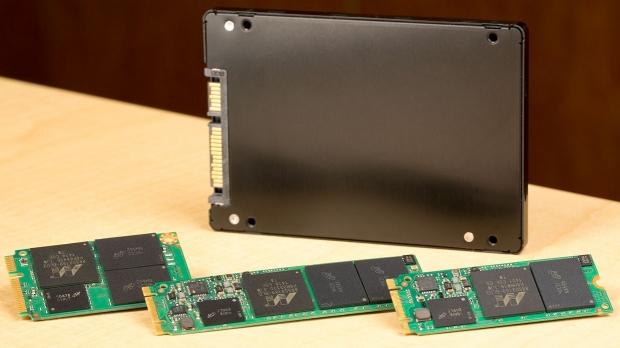
We rarely get to test SSDs headed to the OEM / system integrator market before the drives are released in notebooks, desktops and other full systems. This isn't the first time we've published an article like this, but it's the first time we managed to secure such a wide range of form factors.
Articles like this are great because they establish a baseline for add-in parts. In the coming months, Micron's new M600 SSD will be available in a range of pre-built system, and as an option on custom-built systems from large OEMs. Some OEMs will advertise the M600 under the product name and others will just list a specific capacity SSD.
If you haven't noticed yet, Crucial has big plans for the company's new 16nm lithography MLC. Samsung, Toshiba and SanDisk moved to triple level cell (TLC) flash technology to bring SSDs to the masses, but Crucial chose to continue shrinking MLC. On the aftermarket side, the MX100 has become a popular SSD for those looking for exceptional value. At the time of writing, the Crucial MX100 512GB costs less than $210 - the 16nm NAND flash used on the drive is what makes those prices possible.
From a technical point of view, the M600 takes one part MX100 and one part M550. The same 16nm flash used on the MX100 was used in the M600, but the M550's Marvel 88SS9189 controller was used. Let's dive in now and take a close look.
Specifications, Pricing and Availability
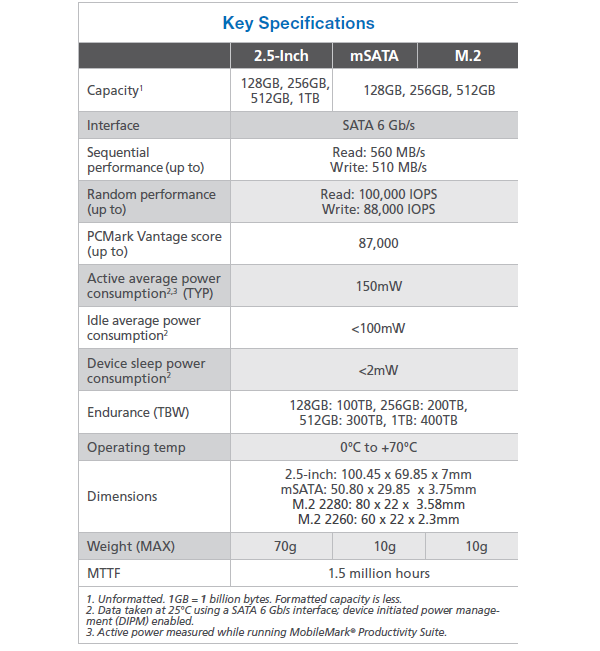
Micron has the M600 in four form factors: 2.5-inch, mSATA, M.2 2280 and M.2 2260ds (double sided). Four capacity sizes are available in the 2.5" form factor, but the large 1TB size is a 2.5" exclusive. The mSATA and two M.2 variants ship in 128GB, 256GB and 512GB capacities. Micron claims sequential read performance up to 560 MB/s. The claimed sequential write speed is up to 510 MB/s. Random performance tips the scales at 100K read IOPS and 88K write IOPS.
Just as impressive is the endurance ratings for the M600 drives. The ratings vary by the capacity size of the drives. The 128GB model delivers 100 TB, and double for the 256GB model, 200TB. The 512GB model gets a 300 TB rating and the massive 1TB drive is rated at 400 TB.
The M600 series is designed to just sip power. DEVSLP is working on the M600, less than 2mW in that state. The idle average power consumption is less than 100mW with DIPM enabled.
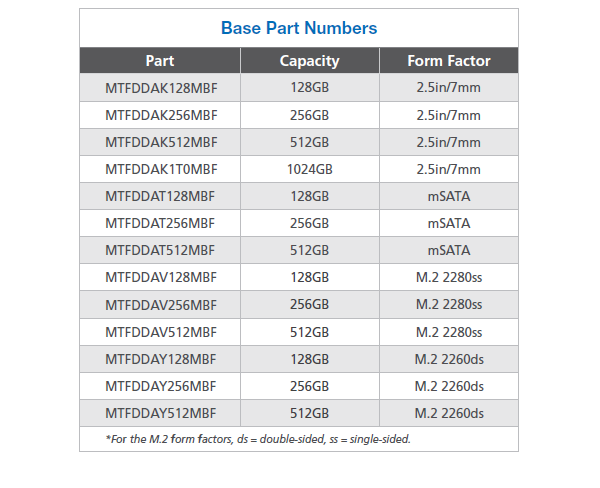
The M600 has several part numbers due to the wide range of form factors and capacity sizes. Since these drives will ship in systems, we don't have any pricing information and the accessory page will depend on what the OEM / SI needs to get the system up and running.

As previously mentioned, the M600 uses Marvell's 88SS9189 controller, the same Crucial used on the M550. The flash is the same 16nm used on the MX100, but the 128GB and 256GB models bring SLC layer functions. Micron calls this Dynamic Write Acceleration. You can read a white paper from Micron that details Dynamic Write Acceleration at this link.
Micron M600 SSDs
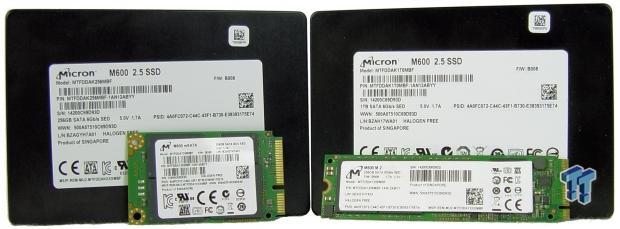
Here we see all four of the samples Micron sent over. In the 2.5" variety, we have the 256GB and 1TB models. The mSATA and M.2 drives are both 256GB capacity drives.
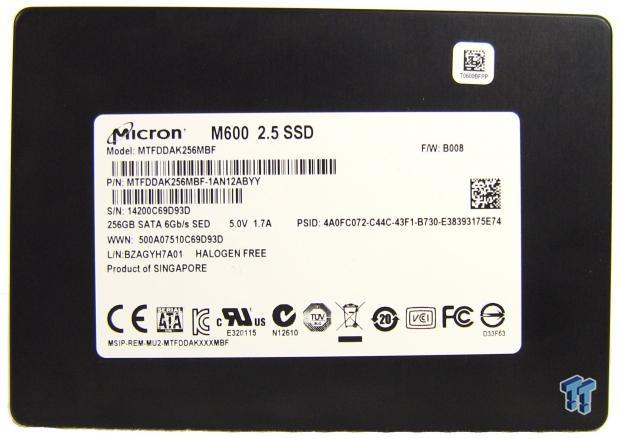
Micron moved away from the dense metal cases found on the consumer Crucial M5x0 series products.


The M600 2.5" drives all ship in a 7mm case so OEMs are able to use the series in Ultrabook designs.


Micron sent over M600 2280 M.2 model. Micron also has a 2260 dual side model that is just 60mm long for very small systems or embedded applications. The M.2 drives use just two NAND packages.

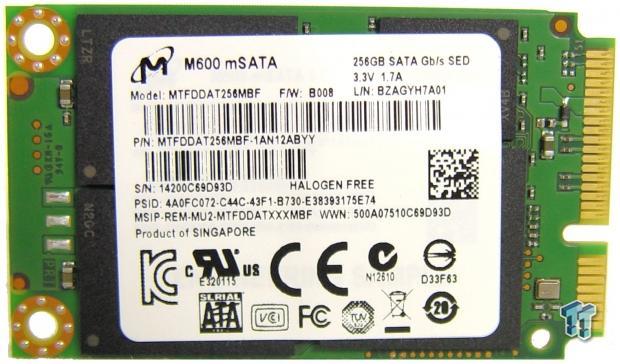
The mSATA model uses the same controller and DRAM as the M.2 drive, but with four flash packages rather than two.

The 256GB drives don't need as many capacitors for host power fail protection. Here we see the pads for more capacitors that would be populated on the 512GB model.

The 1TB 2.5" drive has more capacitors, but still has four empty spaces for more.

The M600 drives all use the Marvell 88SS9189-BLD2 controller. The 9189 is the higher spec successor to the 88SS9187 that has been in use for several years now.

Several companies plan to use the 9189 with TLC flash, but Micron chose to use the 9189 power with 16nm MLC.
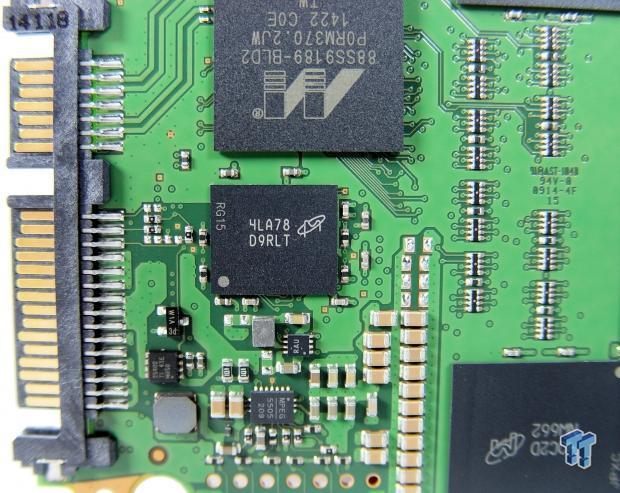
The M600 models use Micron DRAM of varying density that scales larger with increased capacity size.
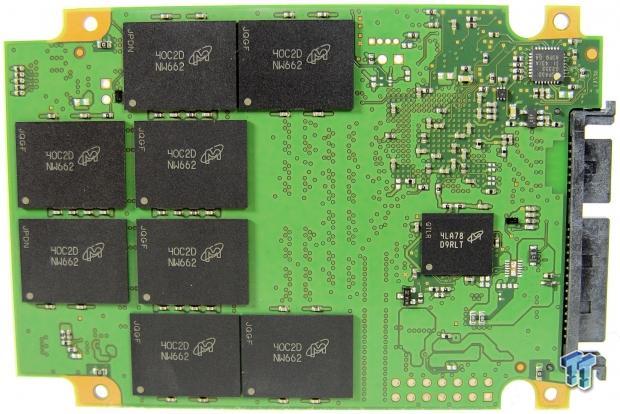
The large 1TB model uses two DRAM packages and sixteen NAND packages.

The 256GB 2.5" drive uses eight flash packages and one DRAM package. The 256GB model also uses a different PCB than the 1TB model.
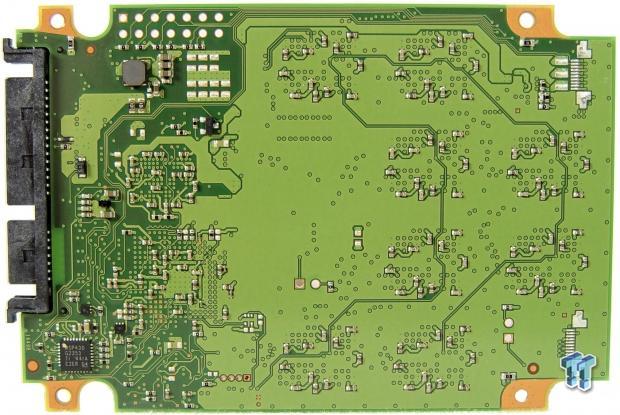
There are twenty spaces for capacitors, but only five are populated.
Test System Setup and ATTO Baseline Performance
Desktop Test System
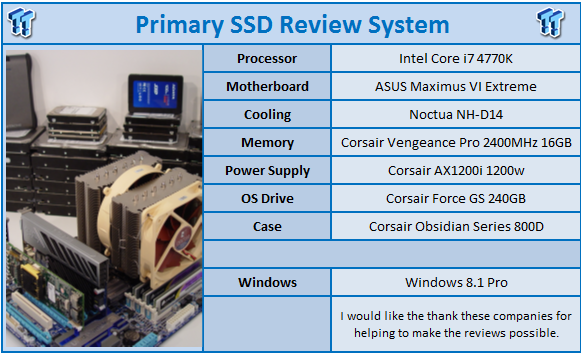
Lenovo T440 - Notebook Power Testing with DEVSLP and Windows 8.1 Pro
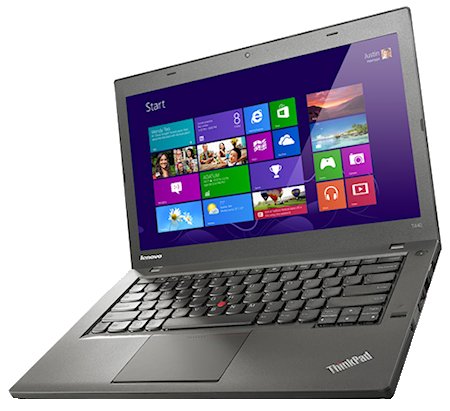
Nearly all of the performance tests run on the desktop system but we use a Lenovo T440 to run the power tests. The T440 is the latest addition to our client SSD test lab and allows us to test the notebook battery life offered by an SSD with advanced features like DEVSLP enabled.
ATTO - Baseline Performance
Version and / or Patch Used: 2.34
Micron M600 256GB

Today we're testing the both 2.5" drives, 256GB and 512GB. Here we see the M600 256GB in ATTO at QD4. The read speed tops out at nearly 565 MB/s, one of the highest we've ever tested on a SATA III device. The write speed is just over 511 MB/s.
Micron M600 1TB
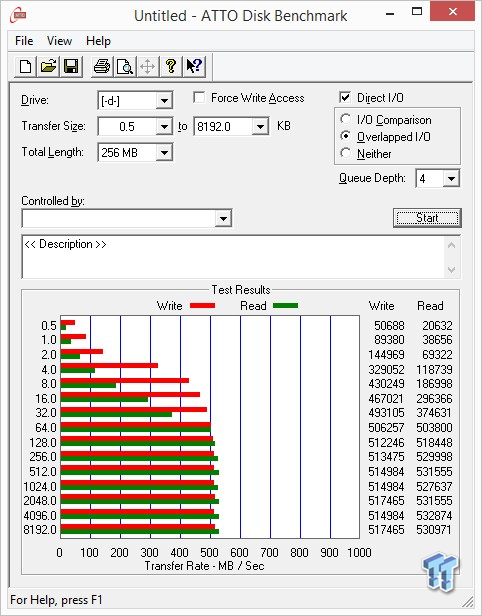
The 1TB model achieved 531 MB/s in the read test. The write speed was a little higher on the 1TB model over the 256GB model, 517 MB/s.
HD Tune Pro - Sequential Performance
Version and / or Patch Used: 5.50

Today we're using the 256GB capacity charts to compare the M600s to other products on the market. The other products on the market are aftermarket parts usually installed by end-user customers.
Most modern SSDs don't have an issue reading data back reliability or quickly.

With modern SSDs, the price has a direct correlation with write performance and performance consistency. The 256GB M600 writes data slower than the 1TB model. This is to be expected since the 256BG model has less flash packages to write to at the same time.
HD Tach - Sequential Write Performance after Random Writes
Version and / or Patch Used: 3.0.4.0
Micron M600 256GB

Micron M600 1TB

After a reasonable amount of random and sequential writes to the drives, we ran HD Tach to measure sequential performance.
The M600 256GB shows a lot of variation in the sequential writes as the drive recovers from the random writes from preconditioning. The large 1TB model had a few peaks and valleys, but the write performance never dropped below 200 MB/s.
Benchmarks - Anvil Storage Utilities
Anvil Storage Utilities
Version and / or Patch Used: RC6
So what is Anvil Storage Utilities? First of all, it's a storage benchmark for SSDs and HDDs where you can check and monitor your performance. The Standard Storage Benchmark performs a series of tests; you can run a full test or just the read or the write test, or you can run a single test, i.e. 4k QD16.
Anvil Storage Utilities is not officially available yet, but we've been playing with the beta for several months now. The author, Anvil on several international forums, has been updating the software steadily and is adding new features every couple of months.
We can use Anvil several different ways to show different aspects for each drive. We've chosen to use this software to show the performance of a drive with two different data sets. The first is with compressible data and the second data set is incompressible data. Several users have requested this data in our SSD reviews.
0-Fill Compressible Data
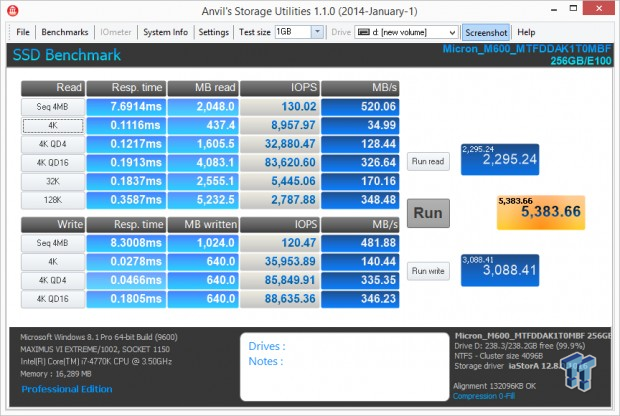
Incompressible Data

The performance with compressible data and incompressible data is the same so you don't have to worry about performance loss while editing audio, video or files that are already compressed. The screenshot above are from the 256GB model.
Micron M600 1TB
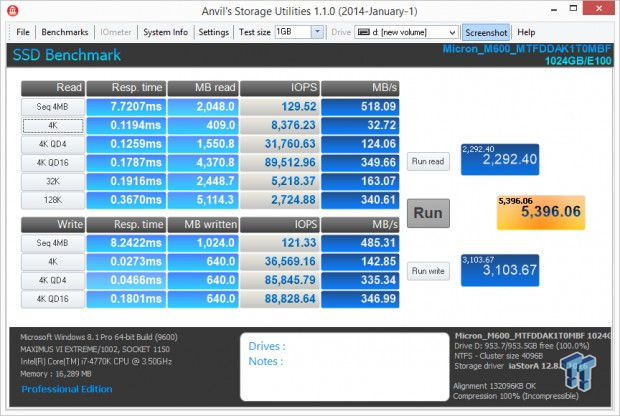
The M600 1TB is just as fast as the 256GB model even without the Dynamic Write Acceleration function.
Low Queue Depth Read IOPS

The 256GB and 1TB model still do very well in the test, both with over 8K IOPS at QD1. The drives scale really well too.
High Queue Depth Read IOPS

Most of us will never hit a high queue depth random read with an SSD. The drives are just too fast to have commands stacked this high under real-world conditions.
Low Queue Depth Write IOPS

The M600 drives reach very high IOPS performance numbers at QD4. The low queue depth numbers are very respectable as well, nearly the fastest on the chart today.
High Queue Depth Write IOPS
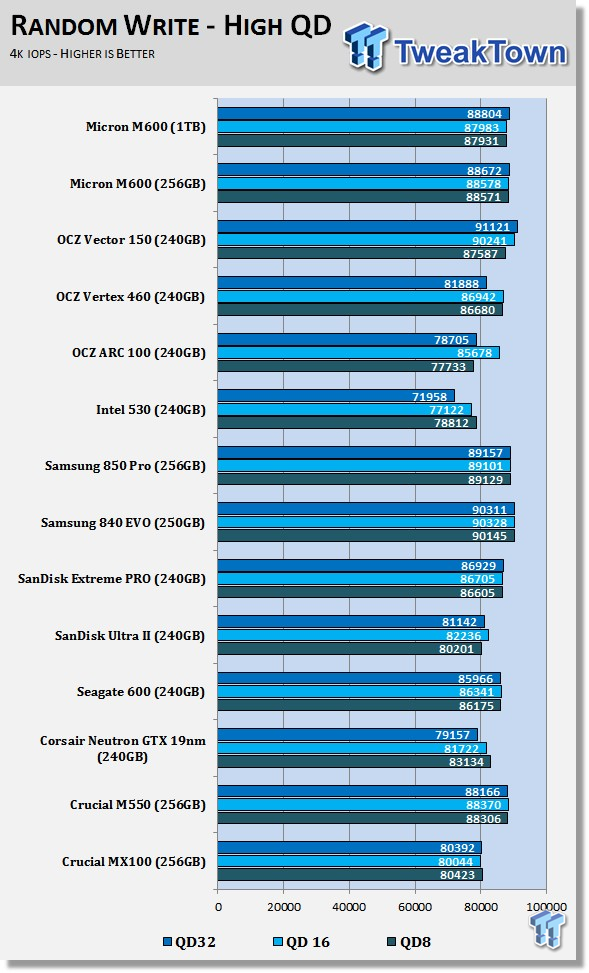
The high queue depth write performance peaked at QD4 in the last chart, but the M600 drives don't lose IOPS performance at high write queue depths.
Benchmarks - Mixed Read / Write Workloads
Sequential Mixed Read / Write Workloads
In this series of tests, we measure mixed workload performance. We start with 100% read and then add data writes to the mix until we get to 100% writes, in 10% increments. We believe this will be the next major area SSD manufactures will address after performance consistency.
Sequential Mixed Workload Bandwidth

Our mixed workload tests show steady state sequential performance at different levels of read and write mixes. These tests are brutal on value focus SSDs and really show how the lower cost drives write performance can drop under intense load.
Sequential 80% Read / 20% Write Bandwidth

Several companies have stated that the 80% read 20% write is the area we should focus on for consumer workloads. The M600 drives are on the lower-end of the scale at this measurement point. We still have yet to test the Crucial M550 in this test, but have it coming up soon in our stack of drives going through the test.
Random Mixed Workload Response Time

Our random mixed IO chart is starting to fill out, but we still have a handful of drives to test. When it comes to random data, the M600 performs really well at all queue depths.
PCMark 8 Consistency Test
Futuremark PCMark 8 Extended - Consistency Test
Version and / or Patch Used: 2.0.228
Heavy Usage Model:
Futuremark's PCMark 8 allows us to wear the test drive down to a reasonable consumer steady state and then watch the drive recover on its own through garbage collection. To do that, the drive gets pushed down to steady state with random writes and then idle time between a number of tests allows the drive to recover.
Precondition Phase:
1. Write to the drive sequentially through up to the reported capacity with random data.
2. Write the drive through a second time (to take care of overprovisioning).
Degradation Phase:
1. Run writes of random size between 8*512 and 2048*512 bytes on random offsets for 10 minutes.
2. Run performance test (one pass only).
3. Repeat 1 and 2 for 8 times, and on each pass increase the duration of random writes by 5 minutes.
Steady state Phase:
1. Run writes of random size between 8*512 and 2048*512 bytes on random offsets for 50 minutes.
2. Run performance test (one pass only).
3. Repeat 1 and 2 for 5 times.
Recovery Phase:
1. Idle for 5 minutes.
2. Run performance test (one pass only).
3. Repeat 1 and 2 for 5 times.
Storage Bandwidth
PCMark 8's Consistency test provides a ton of data output that we use to judge a drive's performance. Here we see the three states of performance for the select SSDs, light use, consumer steady state and worst case.
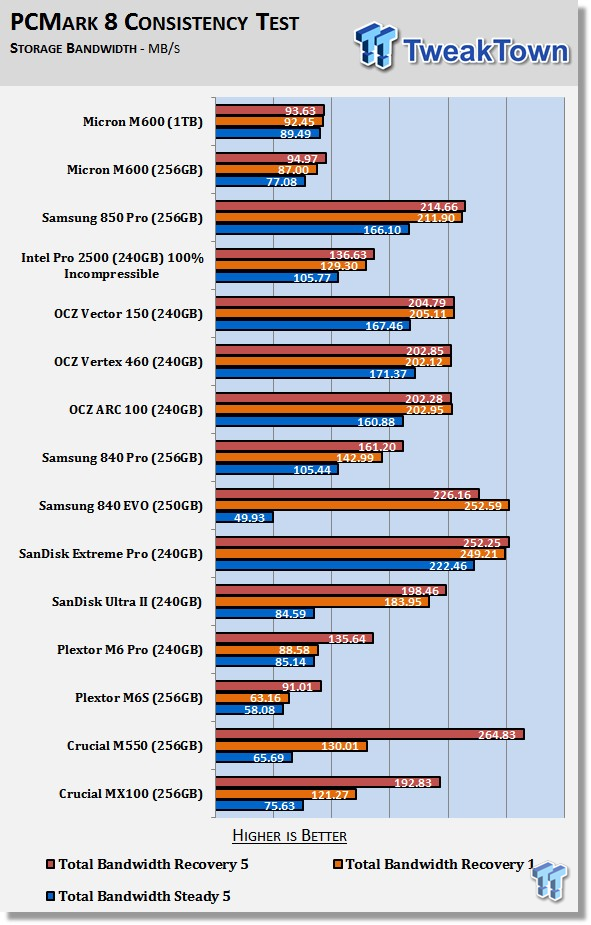
Value minded SSDs tend to fall flat in the consistency tests since these run from a deep steady state to a mildly used state. We expected the performance to fall somewhere between the MX100 and M550, but that wasn't the case.
Storage Bandwidth All Tests
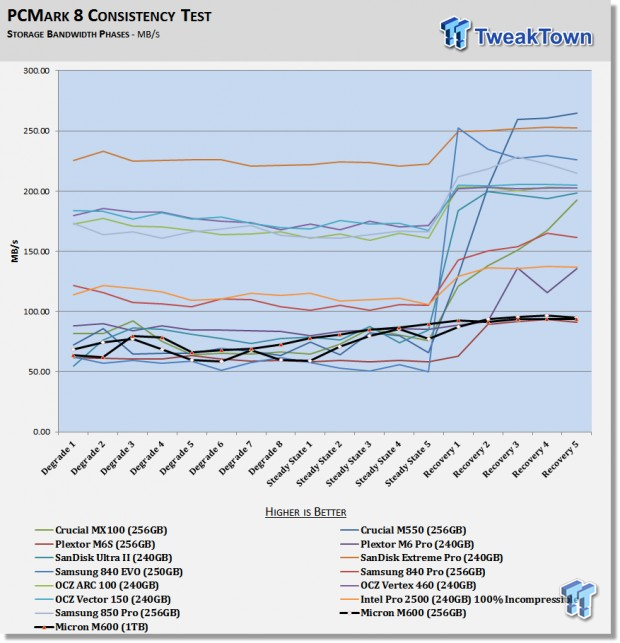
Here we see all of the test stages. The M600 is towards the bottom of nearly every test.
PCMark 8 Consistency Test - Continued
Total Access Time
The access time test measures the total latency across all 18 tests. This is one of, if not the most important test we run at this time for consumer SSDs. When your latency is low your computer feels fast, it's just that simple.

Throughput is one way to measure performance but access time is why most SSD enthusiasts prefer to move away from spinning disks. The M600 drives have more latency in daily use software over the fastest SSDs on the market.
Disk Busy Time
In the final test, we measure the amount of time the drive worked to read and write the data to complete the test. When a drive is active, it uses more power so the faster it can complete the tasks the faster it can fall into a low power state.

Disk busy time shows us how long a drive has to work to complete the assigned tasks. This often gives us deeper insight into power consumption and notebook battery life.
Benchmarks - Power Testing
Bapco MobileMark 2012 1.5
Version and / or Patch Used: 2012 1.5
Developer Homepage: http://www.bapco.com
Test Homepage: http://www.bapco.com
MobileMark 2012 1.5 is an application-based benchmark that reflects usage patterns of business users in the areas of office productivity, media creation and media consumption. Unlike benchmarks that only measure battery life, MobileMark 2012 measures battery life and performance simultaneously, showing how well a system design addresses the inherent tradeoffs between performance and power management.

Micron designed the M600 to sip power. The result from the design is the M600 delivers more notebook on battery time than nearly every other consumer SSD on the market today.
Power Limited Performance

In a power-limited state, the M600 performs tasks very well and is comparable to other drives on the market.
Final Thoughts
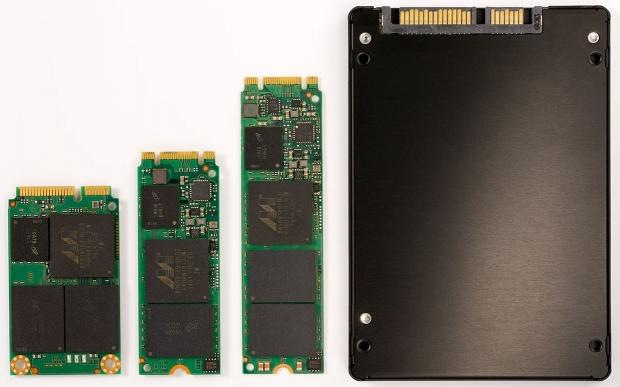
It's important to remember when looking back over the performance charts that Micron didn't set out to build the fastest SSD the company could. The OEM / SI companies don't need the fastest performance to achieve their goals.
If you buy a full system with an SSD, you want the drive for the least amount of money, want a drive that is reliable, has a lot of capacity, and has a lot of endurance. That's the product Micron tried to build, and it looks like Micron hit the mark.
Compared to a mechanical hard drive, the Micron M600 is a magnitude faster, has more endurance and shouldn't increase the cost of the system by a large amount. It will be interesting to see which OEMs pick up the M600 and at what price points the drives will have. Given the large quantities OEMs buy in, the M600 could cost as much as the MX100 or lower. If that holds true, the M600 should be a popular option in new systems.
The real winner is the purchaser. If the M600 helps users progress past HDDs and onto SSDs with lower power, higher performance and increased reliability at a low price, the consumer wins. At this point, mechanical HDDs are best used for long-term storage and not for the operating system.
The technology has been around for several years now and we're excited about seeing SSDs becoming the standard on more systems.

 United
States: Find other tech and computer products like this
over at
United
States: Find other tech and computer products like this
over at  United
Kingdom: Find other tech and computer products like this
over at
United
Kingdom: Find other tech and computer products like this
over at  Australia:
Find other tech and computer products like this over at
Australia:
Find other tech and computer products like this over at  Canada:
Find other tech and computer products like this over at
Canada:
Find other tech and computer products like this over at  Deutschland:
Finde andere Technik- und Computerprodukte wie dieses auf
Deutschland:
Finde andere Technik- und Computerprodukte wie dieses auf